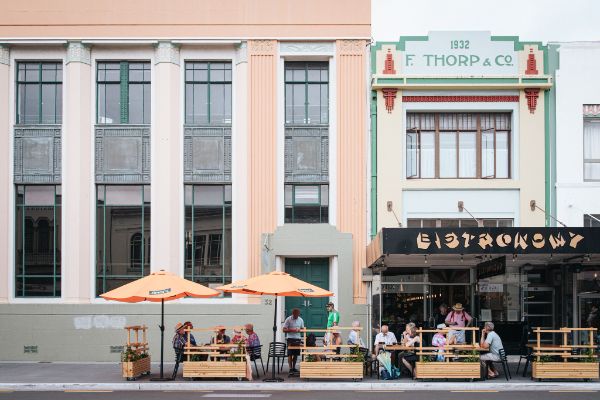
The latest Hawke’s Bay commercial and industrial insights and data report from leading agency Bayleys shows sustained demand for quality assets, yields remaining stable, upwards pressure on rents in the industrial arena, and renewed optimism with international tourism returning to the region.
Bayleys Hawke’s Bay’s commercial manager Kerry Geange said Bayleys’ data supports the heightened activity being seen in the commercial and industrial market, with increased enquiry and investment from outside the region evidence that its sought-after fundamentals carry weight.
“Hawke’s Bay property has traditionally been tightly-held by intergenerational owners and there is a shortage of stock coming to the market as owners opt to hold and watch as the post-COVID economy unfolds,” he said.

“When property does come to the market, we’re noting solid interest from local investors and owner-occupiers, along with a clear uptick in enquiry and transactions from North Island buyers with strong representation from the Manawatu, Waikato, Wellington and Auckland.
“Well-located, high specification property with good tenant covenants sells very well and quickly, and there’s currently a lot of capital in the market looking for opportunity in the commercial and industrial space.”
Benchmark yields for modern commercial and industrial property sit in the 4.9-5.7 percent range.
Leasing-wise, Geange said in-line with the rest of the country, Hawke’s Bay is witnessing a flight-to-quality for office assets, led largely by national tenant occupiers.
“Benchmark net face rents for modern city centre offices are in the $330-$360 per square metre range per annum and we’d expect rises in rents for new-build office developments given escalating construction costs.
“Councils in both Napier and Hastings are driving transformative change in the CBD areas with improved streetscapes, amenities and community facilities which adds another layer of appeal for investors, owner-occupiers and tenants.”
The strength of the regional economy, which continues to be underpinned by the primary sector, is giving investors the confidence to commit to Hawke’s Bay according to Geange.
“While the horticulture sector has had some real challenges around workforce and supply chain over the past couple of pandemic-related years, it remains a core part of the region’s economic well-being.
“We understand there has been a doubling of land planted in apples in the last four years, with new planting regimes effectively and significantly increasing production which in turn is flowing on into the coolstore and packing shed parts of the property mix with new development in the Twyford, Fernhill and Whatatu areas.
“Napier City and Hastings District Councils are looking at the next phase of potential development expansion land with careful consideration given the protections around the highly-productive Heretaunga Plains ‘fruit bowl’ and the changing face of some traditional industrial precincts.”
Industrial occupiers are now gravitating more towards Awatoto, Irongate, and Omahu Road, while Hawke’s Bay Airport is proposing an industrial business park development on airport land.
The gentrification of the formerly industrial Ahuriri area continues with a greater presence of office occupiers interspersed within a vibrant hospitality precinct.
Council is working on its broader inner harbour revitalisation plan for that area, and Mackersey Development Limited’s new West Quay project will feature restaurants, bars and retail at street level with serviced apartments and luxury apartment living above.
Geange said population growth in the Bay is providing stimulus to construction and retail sectors, and the aged care and retirement living sector is flourishing on the back of the region’s demographics.
“There’s also a move to more intensified residential development around core city infrastructure, and we’re seeing some conversion of inner city office blocks to residential accommodation in Napier and Hastings.
“The region hit a population over 160,000 in the last couple of years, and 200,000 is looking likely in the not too distant future.
“That starts to be a critical mass of population which will feed the service and construction industries, and support the service sector.
“I see exciting times ahead for Hawke’s Bay with new projects like the master-planned 207ha Mission Hills greenfield development on Napier’s western urban boundary with its mix of residential homes, upmarket lifestyle block residences, commercial and community hub, reserve areas and walking/cycling networks bringing new opportunity to the area.
“There’s new office development planned for Havelock North which will change up the dynamics of the Village which has seen some progressive new commercial development in recent years.”
The region’s tourism sector – driven by Napier’s art deco fundamentals, Hawke’s Bay’s wine producing pedigree, and an active cruise ship market – took a hit due to border closures, but Geange said there are promising signs that this element of the region’s economy will rebound quickly.
“There are currently about 90 cruises tentatively booked to visit Napier Port during the upcoming cruise season from October to April, with a new $175 million wharf set to improve the port’s accessibility and capacity.
“Retailers and hospitality operators are hanging out for the return of tourists and some sense of normality around event management, despite strong domestic support for the area.”



 Business Canterbury: Urges Council To Cut Costs, Not Ambition For City
Business Canterbury: Urges Council To Cut Costs, Not Ambition For City Wellington Airport: On Track For Net Zero Emissions By 2028
Wellington Airport: On Track For Net Zero Emissions By 2028 Landcare Research: ANZAC Gall Fly Release Promises Natural Solution To Weed Threat
Landcare Research: ANZAC Gall Fly Release Promises Natural Solution To Weed Threat NZ Anti-Vivisection Society: Auckland Rat Lovers Unite!
NZ Anti-Vivisection Society: Auckland Rat Lovers Unite! University of Canterbury: $1.35 Million Grant To Study Lion-like Jumping Spiders
University of Canterbury: $1.35 Million Grant To Study Lion-like Jumping Spiders Federated Farmers: Government Ends War On Farming
Federated Farmers: Government Ends War On Farming



